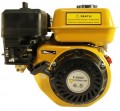Max. torque
The maximum torque developed by the engine during operation. Note that such an indicator is usually achieved only at certain speeds — this nuance can be specified in the characteristics.
Torque can be simplistically described as the force exerted by a motor on a shaft. The higher this effort, the more “high-torque” the motor is, the better it overcomes resistance and handles with high loads. The torque value is directly related to the power. For example, for 5 hp models. and less torque
up to 10 Nm is considered quite normal, engines of 4 – 7 hp. give out
from 10 to 20 Nm, and values
of 20 Nm or more are found in units with a power of at least 8 hp. At the same time, engines of the same power may differ in actual force. So this indicator characterizes the capabilities of the unit well in comparison with analogues.
It is worth saying that many consider torque to be a more reliable and visual parameter than power: the latter can be indicated in different ways (nominal, maximum, etc.), while torque is a completely unambiguous characteristic.
Shaft rotation
Direction of rotation of the motor shaft. Usually, it is indicated by the direction in which the shaft rotates, if you look at it from the flywheel side (from the side of the engine from which the power is taken off). The classic option is counterclockwise rotation, but the opposite direction is also found. Anyway, the main selection criterion for this parameter is what direction the car is designed for, under which the engine is bought.
Shaft length
It is customary to call the shaft length only the length of its outer part protruding beyond the engine housing. The optimal value of this parameter depends on the characteristics of the machine in which the engine is planned to be installed.
Shaft internal thread
The diameter of the internal thread on the motor shaft (more precisely, on its outer end). This information may be necessary for the successful use of the engine with some mechanisms and devices. It can be indicated both as a real value in millimetres (10 mm) and as a marking (5/16-24UNF, M8, etc.).
Compression ratio
The compression ratio provided by the engine.
The compression ratio is the ratio of the total volume of each cylinder (above-piston space at the extreme lower position of the piston) to the volume of the combustion chamber (above-piston space at the extreme upper position of the piston). Simply put, this parameter describes how many times the over-piston space decreases when the piston moves from the bottom to the top.
A higher compression ratio, on the one hand, contributes to an increase in engine efficiency and allows you to achieve more power (compared to analogues of the same volume) and lower fuel consumption (compared to analogues of the same power). On the other hand, with an increase in the compression ratio, the likelihood of detonation (“knocking in the engine”) also increases, which puts forward increased demands on the quality of the fuel.
The lowest compression ratio found in modern engines is about 5.6:1, the highest is about 19:1.
Piston diameter
The engine piston diameter is a reference parameter — in fact, this data is required very rarely, usually, for repairs and other specific tasks that the average user usually does not deal with at all.
Piston stroke
The distance that an engine piston travels from one extreme point to another. In general, it is a rather specific characteristic and is rarely required in fact (for most ordinary users, it is never needed at all in the entire “life” of the engine).
Specific fuel consumption
Specific consumption in this case can be described as the amount of fuel consumed by the engine per hour per 1 kW of generated power. The lower this figure, the higher the efficiency of the engine and the more economical it is. Specific consumption data is especially useful for comparing units with different capacities.

